Accused of Rape and Drug Use, Fatih Seferagic Speaks Out
Fatih Seferagic, a famous Quran reciter from Bosnia known worldwide, has been accused of rape and drug use. He has spoken out...

Kapanlagi.com - Muhammad Taufiq Shaleh Saguanto's (41) action of recycling plastic waste has amazed many people. He showcases his works in the Museum and Education Hot Bottles. His idea of creating an art museum using used plastic bottles is truly beyond the ordinary person's imagination.
Taufiq built a museum filled with his collection of art made from various used plastic bottles. With his skillful hands, he transforms trash into artistic and even economically valuable products.
"I can't help but be a scavenger when I see used items. It's like my soul, my scavenger soul," Taufiq jokingly said with a laugh at his home on Tuesday (7/7).
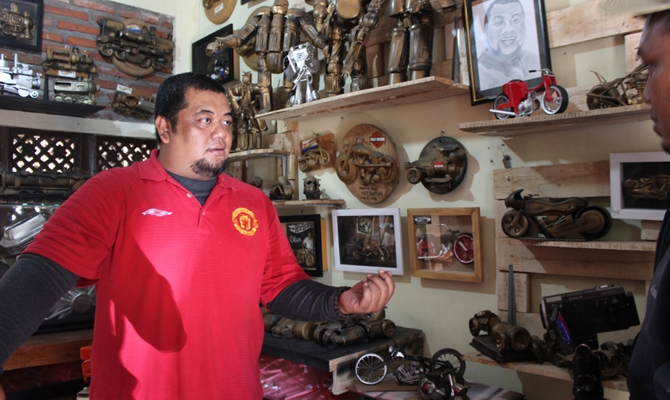
© KapanLagi/Darmadi Sasongko
Taufiq's figure is quite eccentric with a typical fast and loose speaking style of people from Malang. His spirit is full of freedom and he enjoys experimenting, especially supported by his hobby of gathering with various communities which allows him to have many friends.
Together with his family, Taufiq lives in Alam Dieng Risidence Housing, Malang City. The position of his house is located at the corner of the housing entrance, which is partially used as a museum.
Every guest who comes will be greeted by a giant Gundam robot and a motorcycle parked on the roof of the museum. Initially, I thought that the 10-meter robot statue was made of aluminum by looking at its sturdy and hard texture.
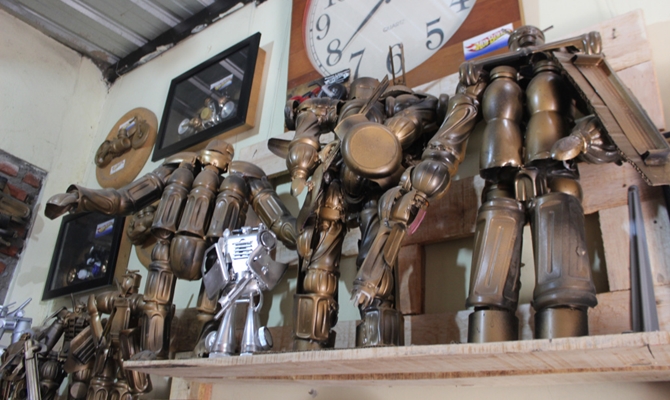
© KapanLagi/Darmadi Sasongko
But after observing more closely, it turns out that the mighty robot is made from various plastic waste. Paint cans function as knee bolts, jerry cans for arm pieces, motorcycle dashboards become shields, and so on, sticking firmly.
Similarly, the old motorcycle parked on top of the museum, people thought it was made of aluminum or similar material. But it turns out to be made from various plastic scraps and leftover metal sheets.
When entering the museum, Taufiq presents another admiration, namely a large motorcycle engine (Moge) in a glass display. The Harley Davidson engine is actually made from leftover asbestos materials that have been touched by artistic craftsmanship.
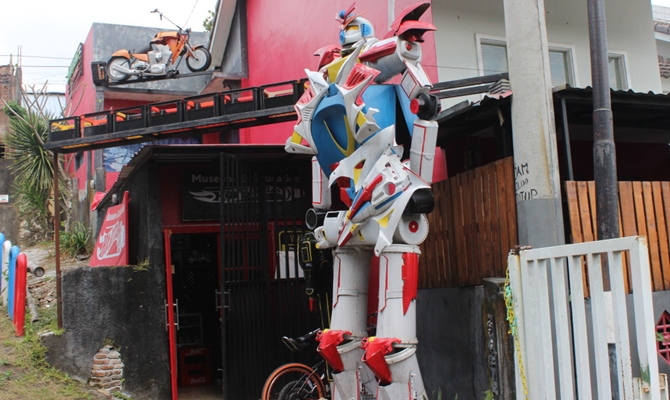
© KapanLagi/Darmadi Sasongko
Taufiq's collection is very diverse, from miniature super cup motorcycles from 1976, Vespa, racing cars, phinisi ships, to the legendary motorcycles commonly used by Dilan. All of his works are made from recycled bottles that are assembled in such a way.
"These small ones are made from straws and plastic spoons," he said.
Taufiq explained that these works originated from a search for a business formula. He searched for a business from something useless that could have economic value.
"I finally found a business tool, finding something from trash, then it can be turned into a product and can be sold. Finally, people believe that starting a start-up doesn't have to require a large capital, but by focusing on creating a ready-to-sell product. The coolest part is when the raw materials are obtained for free," he said.

© KapanLagi/Darmadi Sasongko
But an idea is not just an idea. It turns out that turning trash into something useful and economically valuable is not easy. Failures are often experienced in a design work.
"It doesn't mean that we have a cool idea, trash can become a business start-up, and then the product is instantly ready to be sold. But it turns out that it takes a process, research, and continuous development until it is accepted by the market. But what doesn't disappear is the free capital, from trash," he explained.
His early works were simple and mediocre. He even intended to make a replica of a motorcycle, but when asked by his child, it turned out to look more like a telephone handle.
Taufiq's cheapest work is made from two bottles, two plastic spoons, and two straws, which are sold for Rp20,000. There was also a time when his work was sold for Rp2 million at a seminar event.
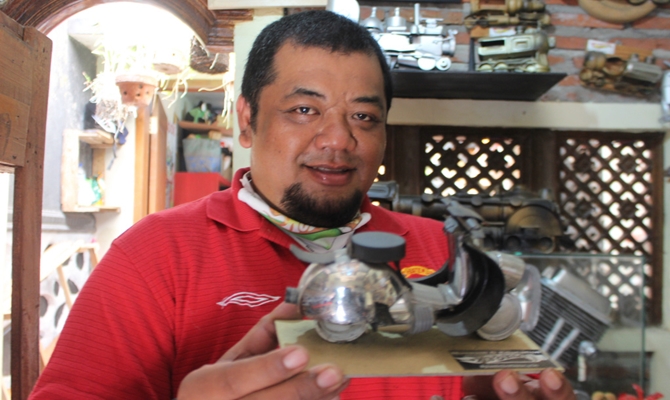
© KapanLagi/Darmadi Sasongko
At that time, at an entrepreneurship seminar, Taufiq asked participants who had plastic bottles. At that time, a miniature was requested and made in front of the seminar participants.
"It took me about 5-10 minutes to process, then it was immediately auctioned and only sold for Rp 30,000, but the highest price ever sold was Rp 2 million. From there, it made people realize that plastic bottles can be turned into extraordinary products, and with a little investment, we can make a significant amount of money," he said.
Initially, Taufiq's work was only sold on online marketplaces. But now, it has also become a collection in several cafes and some have been sold abroad for millions of rupiah.
"Alhamdulillah, over time, I can sell them abroad. The furthest is Canada, Japan, and the biggest market now is Japan. In Africa, it's in the DRC, Democratic Republic of Congo," said this father of three.
"So far, almost 90 percent of the replicas of motorcycles are in demand. The most popular ones are Cooper and custom motorcycles. What makes me proud is that the customers who order them are from Japan. They sell for prices ranging from 8,000 yen to 20,000 yen," he said.
"Most people think that collecting garbage will only earn them a few kilograms of money. But it turns out that with a little repeated research and improvement, even a single bottle can be sold for millions," he added.
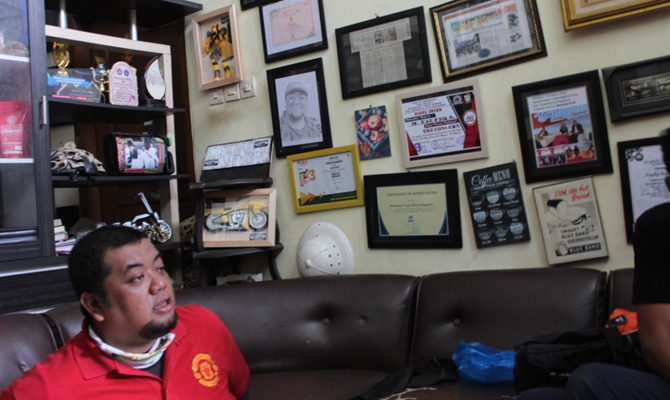
© KapanLagi/Darmadi Sasongko
The number of works has exceeded 600 pieces, making the room crowded. Therefore, some are displayed in the living room as a pride. Taufiq also displays various art works made from used parabolic dishes, which are neatly displayed on the walls of his house.
"If we count from the photos I have collected, there are 600 replica designs that I have made, and I have documented them in a museum. That is the reason why I created a museum. As a place to document, while I haven't had the chance to make a book or a video about the process," he said.
Taufiq is also proud to have many new families in many places in Indonesia, connected through recycled bottles. The bond of brotherhood is in the form of places that are being nurtured.
"The most memorable one is in Makassar. I have a nurturing program, like a fostered village, and the village is located in the middle of the Tamangapa landfill in Makassar. So they really learn from scratch and from the very basics. Now, the people who have the skills are actually there," he said.
For me, Taufiq is a special figure. Not many people can gain knowledge from piles of trash. And he found that path!
(kpl/dar/nda)
Cobain For You Page (FYP) Yang kamu suka ada di sini,
lihat isinya
Fatih Seferagic, a famous Quran reciter from Bosnia known worldwide, has been accused of rape and drug use. He has spoken out...
But who would have thought, it turns out there is a man who looks very similar to Ariel Noah. The man's name is Aris Munandar, from Bandung, and this Ariel look-alike works as a fruit seller on a daily basis.
Cinemas in Jakarta have started operating again and will be open starting July 6, 2020.
Aunty Ernie also revealed some unusual locations for making love that she has used.
Residents of Batu City, East Java are suspected to have been exposed to Covid-19 after close contact at a circumcision event. The man with the case code C-62 had been together and sat at the same table with a guest who later died from positive Covid-19.
This witch doctor in Malang molests a victim who asks for prayer to pass Paskibraka. Read the full story here.
Sad news comes from Banjarmasin. The 'thumb mother' figure who became a legendary icon of RCTI advertisement has passed away. Read more here!
The woman named Prabawati Sukarta was the first voice actress for the character Shizuka.
Aunt Ernie also talks about her hobbies and daily life in her first video post.
Bintang Emon has recently been accused of being a drug user.
Bintang Emon, who was accused of using drugs, claims that he has never even smoked, drank alcohol, or went clubbing. Read more here!
A guy named Roy Ricardo showed the proof of his receipt, which is indeed real and not fake.